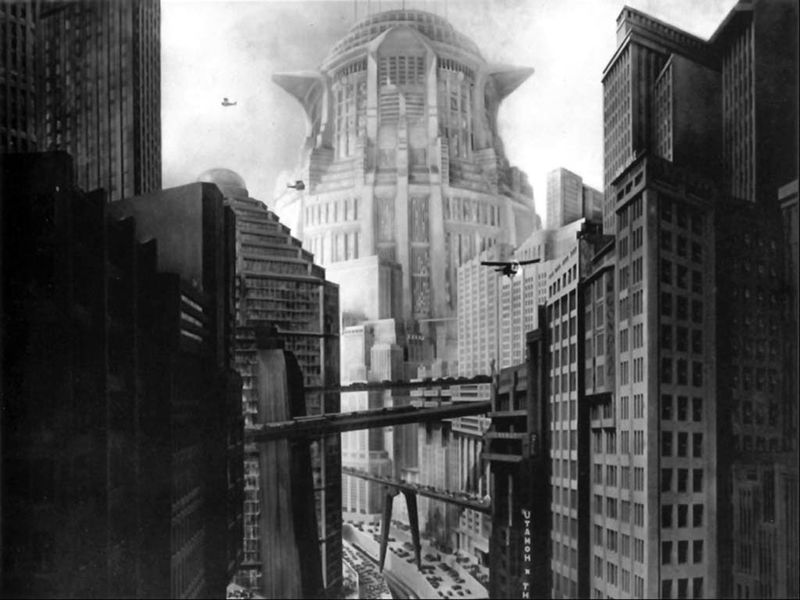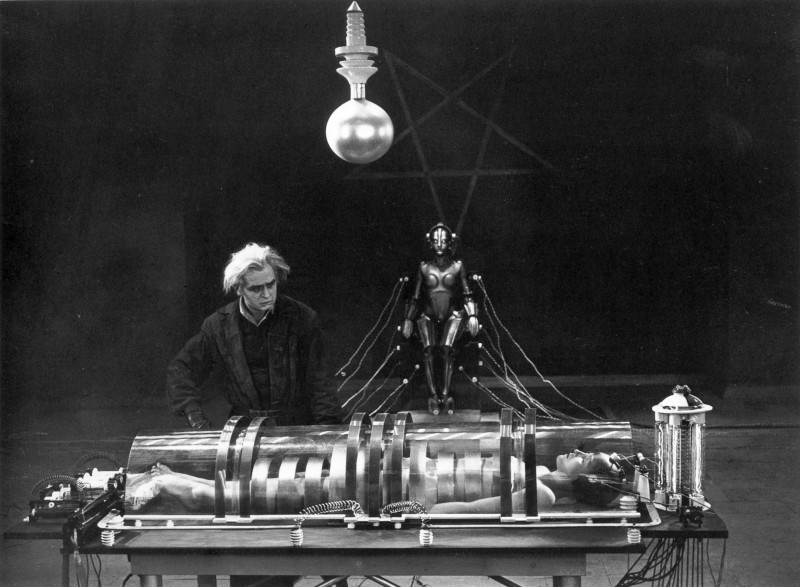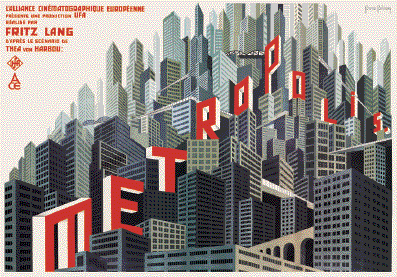Metropolis
Metropolis is a German film made in 1927, directed by Fritz Lang. This is a Sci-Fi/Adventure drama film about a futuristic city which is divided up by class; you have the working class and the city planners. The son of the city’s leader falls in love with a working class prophet who predicts the coming of a saviour. The father does not like this and tries to break things up, but the only way of doing this would be to hurt his son…
I really liked this film because, unlike the other silent films, it was easy to understand just through watching what was happening; the subtitles were like an added bonus. What I liked most about Metropolis was how ideological it was in terms of its approach to the storyline. The BBC said in their review "Narrative logic takes a backseat to rampant expressionism- with sense less important then ideas and startling visuals" indicating that we share the same opinion. I don't see this as a downfall in the production at all however, I actually see it as an ideal approach to a silent movie. Being as expressive as Metropolis is a great, effective way of putting across understanding, meaning and emotion to an audience.
My first thoughts I had when watching the film were that it was about slavery and how the people in power didn’t really care for anyone but themselves. As of now after watching the film I still think it touched upon slavery a little bit, especially from seeing the end and hearing these lines said in the film:-
Freder: It was their hands that built this city of ours, Father. But where do the hands belong in your scheme?
Joh Frederson: In their proper place, the depths.And
Maria: There can be no understanding between the hand and the brain unless the heart acts as mediator.
I interpret both of these extracts as being related to slavery in the way Joh Frederson treated the lower class. He makes them work around the clock and does not care for any of them, even though they built the city which he owns and didn’t help with. The second quote is also very important because I see it as being a moral of the story and something to consider in everyday life. It was something Joh Frederson didn’t consider which is why he was the way he was.
"Few films have ever been more visually exhilarating".
Metropolis’s visual beauty is by far its most appealing factor. The visuals are what make the film so easy and exciting to follow and they truly blow you away. To think of all the ideas and concept work that went into designing the big city alone, with all its advance technology, and all being done in 1927! It’s quite mind boggling. As well as the city they had the idea of having a robot that they made look like the prophet Maria. The design of the robot is impressive and the transformation scene is exceptional, definitely my favourite part of the film.
Transformation scene stills
Robot and Maria being prepared for transformation
lighting effects just before transformation
robot as Maria
Evil Maria causing trouble
Metropolis employed 25,000 extras to create its own world, of course along with its amazing sets and eye-catching special effects. This again is an amazing thing to do in a 1920s film and it should be accredited. The sets were great works of art and to me they are another main attraction of the film. Some of the workers city sets were very outlandish but that was their purpose, to bring you into their world to give you an understanding of how things were, it makes you feel for the characters. As for the more hi tech side of the city it was also very imaginative and again that is what Lang was going for, it gives great contrast between the cities two sides and who occupy them in a very effective manner.
Modern City
Workers
Underground worker city
This is in opposition to the aims of Caligari’s set designs. The Cabinet of Doctor Caligari is set in a fictional world not based off any real world environment, making it less relative and more dreamlike. Also because Metropolis city can in some aspects be presented as a real possibility in our future, taking into consideration the films political and social messages, it makes it all the more saddening. "Like Brazil, Metropolis (Lang 1927) is not meant to portray any existing location but to exploit the unsettling possibility of being anywhere. Like Alphaville, it is designed as a believable vision of a future city".
With the city being such a spectacular design, it must have been inspiring to a lot of other architects and designers looking for ideas. Some of these designers have of course incorporated some of Metropolis’s attributes into their own work. One that has come to mind while looking closer at Metropolis is Anton Furst’s Gotham City from Batman. While this is just my own speculation I have seen many similarities in the two’s design.
Gotham City
Batman in Gotham City
Anton Furst's Gotham City artwork
Gotham City concepts, by Furst

Gotham City, Anton Furst
Metropolis
Underground City, Metropolis 1927
Metropolis movie poster
Metropolis City
This to me looks like Furst has been inspired by Metropolis and has made an adaptation of some sort to help create Gotham City, obviously changing a lot of the scenery and modernising it a bit.
Metropolis is an amazing film which I feel was made before its time. From the robot concepts to the mechanical sets to the vast amount of extras, this film was a trend setter of its day which I thoroughly enjoyed.Bibliography:
http://www.imdb.com/title/tt0017136/quotes - Memorable quotes for Metropolis
http://minadream.com/timburton/AntonsBio.htm - Anton Furst background research






















Great to see you joining the cultural dots, Sean - Metropolis, Gotham City etc. :-)
ReplyDelete